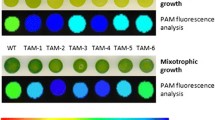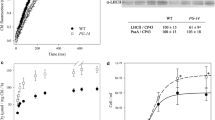Abstract
Microalgae are expected to play a significant role in greenhouse gas mitigation because they can utilize CO2 from power plant flue gases directly while producing a variety of renewable carbon-neutral biofuels. In order for such a microalgal climate change mitigation strategy to become economically feasible, it will be necessary to significantly improve biomass productivities. One approach to achieve this objective is to reduce, via mutagenesis, the number of light-harvesting pigments, which, according to theory, should significantly improve the light utilization efficiency, primarily by increasing the light intensity at which photosynthesis saturates (I s). Employing chemical (ethylmethylsulfonate) and UV mutagenesis of a wild-type strain of the diatom Cyclotella, approximately 10,000 pigment mutants were generated, and two of the most promising ones (CM1 and CM1-1) were subjected to further testing in both laboratory cultures and outdoor ponds. Measurements of photosynthetic oxygen production rates as a function of light intensity (i.e., P–I curves) of samples taken from laboratory batch cultures during the exponential and linear growth phase indicated that the light intensity at which photosynthesis saturates (I s) was two to three times greater in the pigment mutant CM1-1 than in the wild type, i.e., 355–443 versus 116–169 μmol/m2 s, respectively. While theory, i.e., the Bush equation, predicts that such a significant gain in I s should increase light utilization efficiencies and thus biomass productivities, particularly at high light intensities, no improvements in biomass productivities were observed in either semi-continuous laboratory cultures or outdoor ponds. In fact, the maximum biomass productivity in semi-continuous laboratory culture was always greater in the wild type than in the mutant, namely 883 versus 725 mg/L day, respectively, at low light intensity (200 μmol/m2 s) and 1,229 versus 1,043 mg/L day, respectively, at high light intensity (1,000 μmol/m2 s). Similarly, the biomass productivities measured in outdoor ponds were significantly lower for the mutant than for the wild type. Given that these mutants have not been completely characterized in these initial studies, the exact reasons for their poor performance are not known. Most likely, it is possible that the mutation procedure affected other photosynthetic or metabolic processes. This hypothesis was partially validated by the observation that the pigment mutant had a longer lag period following inoculation, a lower maximum specific growth rate, and poorer stability than the wild type.








Similar content being viewed by others
References
Benemann, J. R. (2003). A technology roadmap for greenhouse gas abatement with microalgae, Report to the U.S. Department of Energy, National Energy Technology Laboratory and the IEA Greenhouse Gas R&D Programme.
Huesemann, M. H., Bartha, R., Hausmann, T. S., & Benemann, J. R. (2003). An innovative approach for screening marine microalgae for maximum flue gas CO2 biofixation potential. Proceedings of the Second Annual Conference on Carbon Sequestration, Alexandria, VA.
Pedroni, P., Davison, J., Beckert, H., Bergman, P., & Benemann, J. (2001). A proposal to establish an international network for biofixation of CO2 and greenhouse gas abatement with microalgae. Proceedings of the Department of Energy NETL First National Conference on Carbon Sequestration, Washington DC, May.
International Energy Agency (IEA) Greenhouse Gas R&D Programme, International Network on Biofixation of CO2 and Greenhouse Gas Abatement with Microalgae, http://www.ieagreen.org.uk/
Sheehan, J., Dunahay, T., Benemann, J., & Roessler, P. (1998). A look back at the U.S. Department of Energy’s Aquatic Species Program—biodiesel from algae. NERL/TP-580-24190. Golden, CO: National Renewable Energy Laboratory 80401, July.
Goldman, J. C. (1979). Outdoor algal mass cultures—II. Photosynthetic yield limitations. Water Research, 13, 119–136.
Polle, J., Kanakagiri, S., Benemann, J. R., & Melis, A. (2001). Maximizing photosynthetic efficiencies and hydrogen production by microalgal cultures. In J. Miyake, T. Matsunanaga, & A. San Pietro (Eds.), Biohydrogen II (pp. 111–130). Oxford, UK: Pergamon, Oxford University.
Melis, A., Neidhardt, J., & Benemann, J. R. (1999). Dunaliella salina (Chlorophyta) with small chlorophyll antenna sizes exhibit higher photosynthetic productivities and photon use efficiencies than normally pigmented cells. Journal of Applied Phycology, 10, 515–515.
Sukenik, A., Falkowski, P. G., & Bennett, J. (1987). Potential enhancements of photosynthetic energy conversion in algal mass culture. Biotechnology and Bioengineering, 30, 970–977.
Torzillo, G., Pushparaj, B., Masojidek, J., & Vonshak, A. (2003). Biological constraints in algal biotechnology. Biotechnology and Bioprocess Engineering, 8(6), 1–11.
Burlew, J. S. (1953). Algae culture, from laboratory to pilot plant. Carnegie Institute of Washington, Introduction, Volume 600.
Weissman, J. C. (1978). Bioconversion of Solar Energy, PhD Thesis, University of California, Berkeley, California.
Geider, R. J., & Osborne, B. A. (1992). Algal photosynthesis: The measurement of algal gas exchange. New York: Chapman and Hall.
Kok, B. (1953). Experiments on photosynthesis by Chlorella in flashing light. In J. S. Burlew (Ed.), Algal culture: From laboratory to pilot plant (pp. 63–75). Washington, DC: Carnegie Institution of Washington.
Nakajima, Y., & Ueda, R. (1997). Improvement of microalgal photosynthetic productivity by reducing the content of light harvesting pigment. Journal of Applied Phycology, 9, 503–510.
Nakajima, Y., & Ueda, R. (2000). The effect of reducing light-harvesting pigment on marine microalgal productivity. Journal of Applied Phycology, 12, 285–290.
Nakajima, Y., Tsuzuki, M., & Ueda, R. (2001). Improved productivity by reduction of the content of light-harvesting pigment in Chlamydomonas perigranulata. Journal of Applied Phycology, 13, 95–101.
Bennoun, P., & Delepelaire, P. (1982). Isolation of photosynthesis mutants in Chlamydomonas. In M. Edelman, R. B. Hallick, & N.-H. Chua (Eds.), Methods in chloroplast molecular biology (pp. 25–38). Amsterdam, The Netherlands: Elsevier Biomedical.
Krause, G. H., & Weiss, E. (1991). Chlorophyll fluorescence and photosynthesis: The basics. Annual Review of Plant Physiology and Plant Molecular Biology, 42, 313–349.
Jeffrey, S. W., & Humphrey, J. F. (1975). New spectrophotometric equations for determining chlorophylls a, b, c 1, and c 2 in higher plants, algae and natural phytoplankton. Biochemie Physiologie Pflanzen, 167, 191–194.
Falkowski, P. G., & Raven, J. A. (1997). Aquatic photosynthesis. Malden, MA: Blackwell Science.
Tett, P., Kelly, M. G., & Hornberger, G. M. (1975). A method for the spectrophotometric measurement of chlorophyll a and pheophytin a in benthic microalgae. Limnology and Oceanography, 20(5), 887–896.
Nakajima, Y., Tsuzuki, M., & Ueda, R. (1999). Reduced photoinhibition of a phycocyanin-deficient mutant of Synechocystis PCC 6714. Journal of Applied Phycology, 10, 447–452.
Nakajima, Y., & Itayama, T. (2003). Analysis of photosynthetic productivity of microalgal mass cultures. Journal of Applied Phycology, 15, 497–505.
Acknowledgment
The authors thank Dr. J. Polle at Brooklyn College of CUNY for generating and providing the Cyclotella mutants for this work.”
Author information
Authors and Affiliations
Corresponding author
Rights and permissions
About this article
Cite this article
Huesemann, M.H., Hausmann, T.S., Bartha, R. et al. Biomass Productivities in Wild Type and Pigment Mutant of Cyclotella sp. (Diatom). Appl Biochem Biotechnol 157, 507–526 (2009). https://doi.org/10.1007/s12010-008-8298-9
Received:
Accepted:
Published:
Issue Date:
DOI: https://doi.org/10.1007/s12010-008-8298-9




